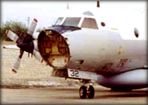 An EP-3E ARIES II in
China
An EP-3E ARIES II in
China
Captured Link. http://home.wxs.nl/~p3orion/hainan.html
 An EP-3E ARIES II in
China
An EP-3E ARIES II in
China
DISCLAIMER:
"THIS WEBSITE IS IN NO WAY CONNECTED WITH ANY OFFICIAL AUTHORITY. THE P-3 ORION RESEARCH GROUP IS A PRIVATE INITIATIVE OF PEOPLE WHO ARE WELL DISPOSED TOWARDS THE LOCKHEED-MARTIN P-3 ORION."
Last updated: 15 July 2001
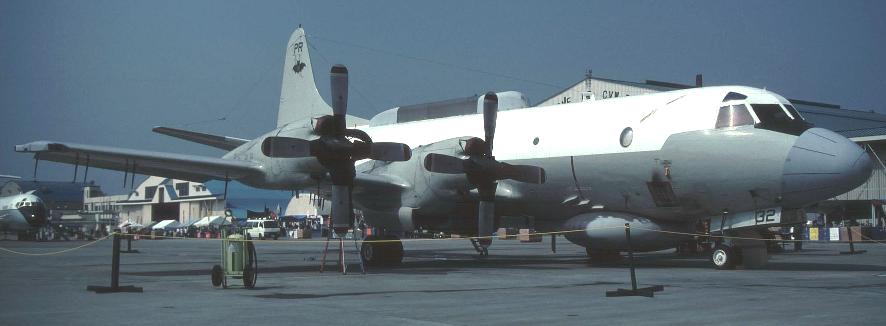
EP-3E ARIES II 156511/PR-32 of VQ-1 in better days (NAS Atsugi, Japan - photo Takafumi Hiroe / July 2000)
US Navy EP-3E ARIES II 156511/PR-32 has been forced to make an emergency landing in China after what officials describe as a "minor" mid-air collision with a Chinese fighter jet. The incident occurred at approximately 0915 local time Sunday April 1 over the South China Sea when two Chinese Navy Shenyang F-8-II "Finback" fighters intercepted the EP-3 surveillance plane during what the U.S. Navy says was a routine patrol flight.
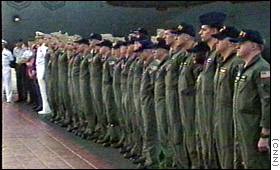 .
. 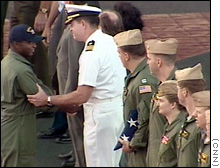 .
. 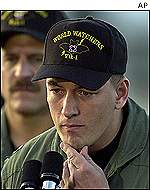
Reconnaissance Crew ONE on arrival at Hickam AFB on Thursday 12 April 2001 (CNN) and Mission Commander LT Shane Osborn telling about the incident after arrival at NAS Whidbey Island on 14 April 2001 (AP)
Click on one of the featuring items for more information:
THE INCIDENT INFORMATION LINKS THE EP-3E ARIES II THE CREW THE MISSION
THE DAMAGE THE LANDING GETTING HER OUT OF CHINA
Sunday April 1,at approximately 0915 local time, one of the Fleet Air Reconnaissance Squadron ONE (VQ-1) Lockheed Martin EP-3E ARIES II surveillance aircraft (BuNo 156511, side code PR-32) was on a routine operation over the South China Sea. It was about 70 miles off the Chinese Island of Hainan in international airspace. Chinese fighters intercepted the aircraft, and one of them bumped into the wing of the EP-3E aircraft.
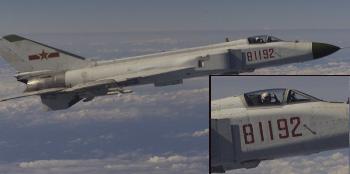
This shows how close the Chinese F-8-II intercepters sometimes are.
At that time the pilot of the aircraft, declared a mayday. A mayday is an in-flight emergency when the pilot figures that there is enough danger to his aircraft that he needs to go to the nearest airfield and land it in order to be safe for his crew and his airplane. He declared that mayday emergency and then turned to the military airfield at Lingshui, which was the closest airfield to land. Immediately after landing the crew informed the USN that all 24 military personnel on board were safe and the plane had landed safely. After the emergency landing the Chinese have kept the USN crew detained until April 11. The crew arrived at Hickam AFB, Hawaii on April 12, after a brief stop at Guam. At Hickam they were de-briefed before travelling to their home base NAS Whidbey Island on April 14.
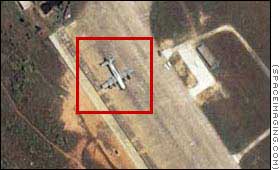 .
. 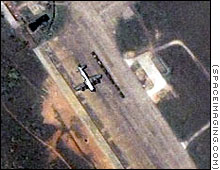
The EP-3E at Lingshui, seen from a
sattelite... the right photo was taken on 10 April 2001 and shows seven trucks lined up alongside the aircraft. This might be evidence that the Chinese are taking equipment off the ARIES II (photos: spaceimaging.com, via CNN)
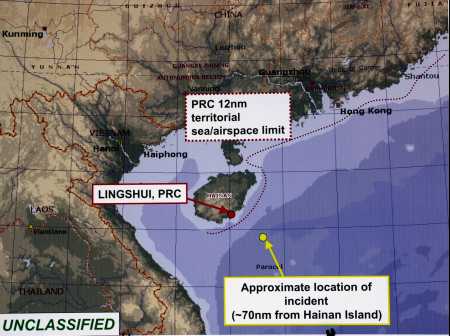
Missing nose radome:
the nose radome was ripped of in flight during the mid air collission. Not only the nose radome but also the equipment it most likely houses is gone. The radome can be opened upwards so if it was ripped off in flight it would have gone up, most likely causing damage to the windscreens and cockpit roof.. 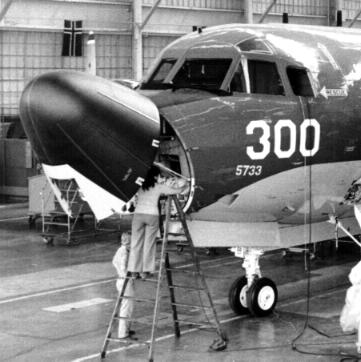 .
. 
The nose radome, seen in half open position on a P-3C Orion (left; Lockheed Martin photo). The photo on the right shows the condition of the nose of the EP-3E in China (Xinhua News Agency photo).
Damaged propeller:
the propeller of engine #1 is heavily damaged so for sure it hit "something". The prop is not feathered so it undoubtly caused a lot of vibrations and probably kept turning despite the engine was shut down. As can be concluded from the kind of damage, the prop slammed into "something big" (the damage is both at the tips of the prop blades and at the lower part near the center). I do not know the colours of the Chinese F-8 but appearantly the EP-3E´s prop was hit by something black. As the nose radome of the aircraft is made out of honeycomb and composite material it is highly unlikely that the damage to the prop was caused by (parts of) the radome alone. Obviously the F-8 and EP-3E were so close to eachother that the vertical stabilizer of the F-8 came into the propeller. Exactly the same thing happened when a Soviet Flanker tried to accelarate from his position below the right wing of a Norwegian P-3B. From an eye witness report written by one of the crew members of the Norwegian aircraft in September 1987: "...the Flanker flew less then 5 meters from the P-3 and moved slightly outwards, diving back in just below the right wing. The jet´s afterburners were ingited as it pulled up, hitting the #4 propeller on the P-3 with its right vertical stabilizer." It is very likely that something similar happened between the American EP-3E and the Chinese F-8. With the F-8 making a manoeuvre like the Su27 it could be possible that the fighter hit the EP-3E´s propeller with its vertical stabilizer, lost control for just a second and accelerated from its position on the left hand side slightly right of its original course, ending up in front of the patrol plane and touching (and damaging) the nose radome with its aft fuselage...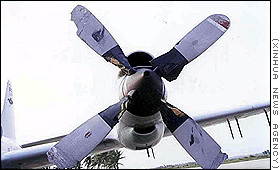 .
. 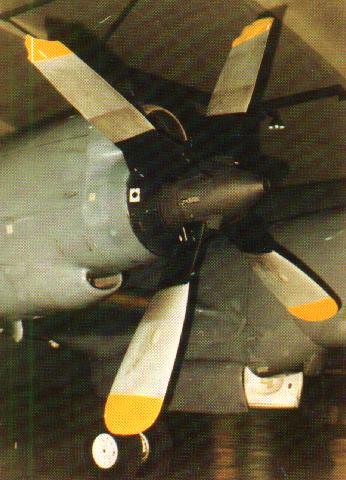
The badly damaged propeller of engine #1 of the EP-3E (left) compared to the propeller of engine #4 on a Norwegian P-3B Orion which was hit by the vertical stabilizer of a Soviet Su27 Flanker in September 1987.
Damage below wing:
in the pic of the left hand wingtip with the broken off antennas the antenna mounts are bent forward (or at least seem to be) this at least suggests that whatever broke the antennas off may have been coming from the back of the aircraft and traveling forward. This might suggest that the above mentioned theory that the Chinese F-8 was flying in (way too) close formation below the EP-3E´s left wing is pretty close to what really happened on April 1 over the South China Sea.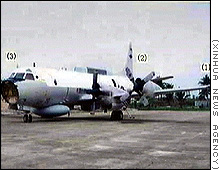
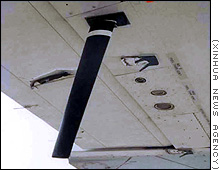
Chinese news photos of the ARIES II at Lingshui AB. The photo on the right show the left wing seen from below and photographed in the direction of the wing tip. The black antenna in the front is not damaged but two more of these are ripped off from behind as can be concluded from the remaining mounts. Just behind the antenna is a cut in the aileron.
Structure damage:
Following the collision the EP-3E plummeted 8,000 feet before the pilot succeeded in righting it. It is not unlikely that such a manoeuvre has caused structure damage to the airframe. But the P-3 airframe is a tough birdie. In September 1988 one of the weather reconnaissance WP-3D Orions of the NOAA (an aircraft with basically the same airframe as the EP-3E) went out of control when the pilot wanted to enter hurricane Hugo. After defying what may have been the worst beating a P-3 has ever taken, a maintenance team found out that there were no new cracks that could be attributed to the violent entry into Hugo´s eye. The G-meters were checked for accuracy and the comclusion was that this P-3 had resisted +5.6 and -3.9 G, where the airframe is rated for +2.5 and -1 G... Of course the two situations are completely different but the WP-3D Hugo experience illustrates that the EP-3E should be able to withstand a lot of stress without causing much structure damage.What happened
After the release of the crew more details regarding LT Osborn's attempt to
land the EP-3E became available. Osborn was both senior pilot and the Mission
Commander.
He says the Chinese F-8 had made two passes near the EP-3E never
more than 5
feet off the port wing! On the third pass, it came in too fast
and the pilot attempting to
decelerate brought up the nose of the jet to
bleed speed. In so doing, the pilot lost some fine control and the jet's tail
came up under the #1 propeller. Sliced by the prop, the Chinese jet...minus its
tail...broke in two and fell away. Part of the F-8 or part of the #1 engine prop
hit the radome. The cone spun away and, in turn, hit the #3 propeller.
With
two of its four propellers out of commission, the EP-3E began rolling over... LT
Osborn says after the initial impact with the #1 propeller and the radome damage
and
the subsequent damage to the #3 propeller, the plane went into a 130
degree roll and came VERY CLOSE to going completely inverted......He says
another few seconds and it would have be unrecoverable......and the crew
wouldn't have had an easy time trying to get out of the aircraft. With the
radome gone, Osborn had no idea of his air speed or altitude. Further, air
rushing against the flattened nose violently buffeted the plane. Osborn says
that as soon as he regained control of the plane, he immediately began
transmitting a Mayday call.....he did so at least 10 times....he received no
reply... although Osborn does say he was in no position really to hear any reply
as he was unable to hear due to the holes in the pressure bulkhead causing air
noise to enter the aircraft... Osborn told U.S. Defence Secretary Donald
Rumsfeld, in a telephone call en route from Guam to Hawaii, that all the EP-3E's
flight controls were behaving oddly after the collision. Osborn says it wasn't
until he was on the ground at Hainan Island that he discovered that debris was
wrapped around the tail of the EP-3E!
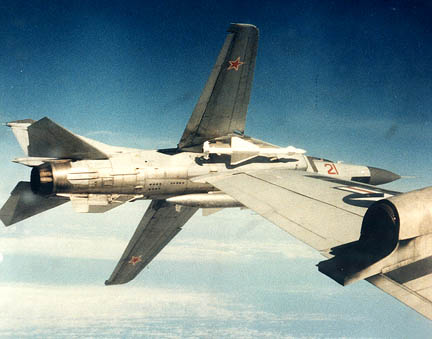
This is how it must have looked like when the Chinese fighter made its first two passes alongside the EP-3E. On this photo a Soviet MiG23 is seen banking away from the left wing of an EP-3E ARIES a couple of years
ago.LT Patrick Honeck was standing behind the cockpit's right seat, where Mission
Commander LT Shane Osborn was seated, when he noticed a Chinese F-8 jet pull up
under the port wing.... Honeck says ' it was kind of surreal,' , who was, at the
time , writing notes about midair harassment that has long been commonplace
during
electronic surveillance missions. After the collision and after the
crew had regained control of the EP-3E... Honeck said they knew they could never
make it home to Okinawa, but that they thought about trying to limp to the
Phillipines. He says the damaged #1 propeller was spinning so wildly that he was
afraid it would lose all of its oil, come loose and shear the EP-3E's fuselage.
He also says that following the impact there was no time for the crew to use
oxygen masks and for a short time, until the plane got down to about 12,000
feet, it was somewhat difficult to breathe.
Mission navigator, LTJG
Regina Kauffman, set a course for Hainan Island. Honeck said it took about 15
minutes more for the plane to make a harrowing but ' fairly benign ' landing at
Lingshui airfield, considering that the aircraft was operating on only three
engines and was not able to use its damaged landing flaps to reduce air speed.
Honeck says that some of the technicians in the rear of the aircraft, unable to
have a look through a window, were not certain right up to touchdown, that they
were not crash landing in water!
An experienced P-3 aviator told me:
in an EP-3E, flight with three engines can not be sustained at altitudes above 18,000 ft, slightly higher if they are on the end of the track. This would explain the loss of altitude. This has happened me (loss of altitude with the loss of an engine from FL270) This will give them the 8000 feet altitude loss that happened. Now the radome coming off is not big of a deal because this has happened many times on a P-3. The aircraft can fly with out it. The big deal is the #1 engine. The Prop looks like its still in the flight range so it was probably vibrating like mad, and if the ehandle was pulled this probably made things worse. Damned if you do and damned if you dont. One can only imagine what was going on inside the cockpit. If the ehandle was not pulled the noise must have been incredible. Another ugly thing is an EP-3 doing a NO FLAP, NO AIRSPEED, THREE ENGINE LANDING. Three engine is no big deal, but with the added no-flap this makes it a big deal. The pilot did a good job getting it down."One of the reports which cannot be confirmed by the photos of the damage said that the EP-3E´s flaps were not working anymore. According to experienced P-3 pilots this would not have been a problem to land the aircraft. One of them told me: "... I can not tell if the punctured flaps could be extended or not. But on a general basis I can say that a no-flap landing is no big deal. It depends on center of gravity, weight of the aircraft, runway length etc. It must be within limits or it is not recommended. We train on no-flap landings on a regular basis..."
Not being able to read out the actual speed from the airspeed indicators, as reported by the officials who were able to speak to the crew, was a bigger problem. The airspeed indicators are getting part of their information via the pitot tubes which are installed on both sides of the front fuselage, just aft of the nose radome. On the photos it is hard to see if the pitot tubes are damaged or not, but given the fact that there was at least some damage to the radome it is not unlikely that the pitot tubes are damaged or simply broken off.
A P-3 pilot told me: "As far as landing without an ASI; you could use the
doppler speed (ground speed vice air speed though) corrected for wind speed and
be able to deduce the air speed for the approach. I have used this in a Buffalo
a/c, and it felt quite comfortable. The pilot could have asked for an a/c to fly
in formation with him, and follow him down, the other a/c flying the correct
speeds......in this case that might not have been a practical solution. If all
else fails, the pilot could have flown power settings and this would equate to a
certain speed that he would know by experience.......with the damage to the
airframe, and the resultant extra drag, this might not be very effective in this
case. If all else fails, the pilot would be able to fly the approach, "guessing"
the speed across the ground visually, and adding a "comfort factor" ........
this again would be a last case scenario based on experience, and definitely the
last choice!"
Once the crew was safely back on American soil, U.S. officials vehemently rejected China's version of how the accident occurred, saying the Chinese pilot clipped the Navy plane while flying a dangerously close intercept mission. The eight-member U.S. team, headed by Defense Department official Peter Verga, was expected to inform the Chinese that reconnaissance missions -- suspended in the aftermath of the crash -- would resume shortly and to demand that Chinese pilots back off from their aggressive flying over international waters.
"We are here to meet with the Chinese government on the 18th to exchange information regarding the incident with our reconnaissance aircraft and that is all," Verga said when the team arrived in Beijing.
The Bush administration outlined four items of discussion for the meeting, scheduled to begin on April 18 at the Chinese Foreign Ministry:
• The cause of the collision
• How to avoid such accidents in the future
• Chinese intercept practices
• The return of the EP-3E
The Chinese have dismissed U.S. claims of innocence, in spite of descriptions of the collision by returning members of the EP-3 crew -- and videotape from previous missions showing Chinese pilots apparently flying their jets within a few feet of the slow moving surveillance plane. "We already noticed that some senior U.S. government officials have made irresponsible remarks," said Foreign Ministry spokeswoman Zhang Qiyue. "They want to ignore the facts, confusing right and wrong and want to shift responsibility onto others, and we express our strong dissatisfaction with this."
How did the EP-3E return to the States?
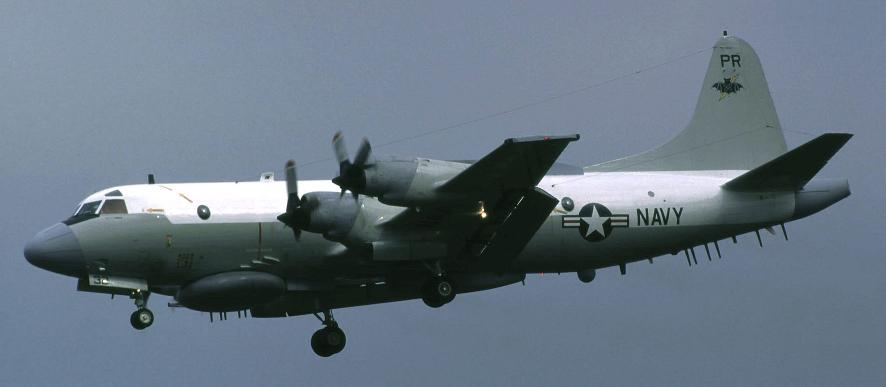
156511/PR-32 of Fleet Air Reconnaissance Squadron ONE landing at NAF Atsugi in September 1998 (photo: Takafumi Hiroe)
After negotiations with Chinese officials the US government decided to airlift the fuselage. An option which required a lot of work. It was a proven concept. After the crash landing of an EP-3E at Souda Bay in Greece that particular aircraft was flown the USA onboard a US Air Force C-5B Galaxy! For political reasons it was decided not to use a US military aircraft to do the job, but to lease a Russian Antonov An124 "Condor" to do the job.
A Lockheed-Martin recovery Team arrived at Lingshui AB on 15 June 2001. Their equipment was flown into Lingshui by the Antonov An124 the next day and the team completed the first inspections on 17 June 2001. On 18 June the EP-3E was repositioned to a working area on the air base and fuel, oil and hydraulics fluid was removed from the plane. After that the Recovery Team started to dismantle the aircraft and make it ready for shipment onboard the Antonov. On 29 June 2001 the EP-3 Recovery Team completed disassembly operations on Lingshui. The team prepared aircraft components and support equipment for transportation back to Kadena and the United States, and began final work site cleanup. On 2 July 2001 The team loaded EP-3 parts onto the An124. The parts were taken to Kadena Air Base, Japan. The team prepared aircraft components and the EP-3E fuselage for final transportation back to United States. Finally on 3 July the An124 left Hainan, China at 4:45 a.m. (EDT) loaded with the fuselage and salvageable parts of Navy EP-3E surveillance plane. It arrived in Manila, Republic of the Philippines to refuel and continued its flight to at Hickam AFB, Hawaii. Following an overnight layover in Hawaii, the An124 departed Hickam on 4 July to arrive at its final destination, Dobbins AFB, Ga., on 5 July 2001.
A photographic report of the EP-3E recovery operation at Lingshui AB:
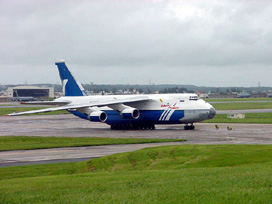 .
. 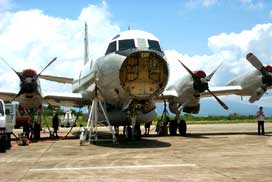 .
. 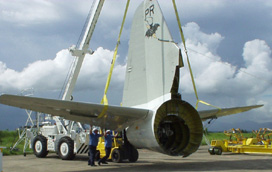
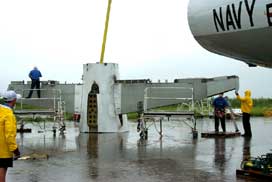 .
. 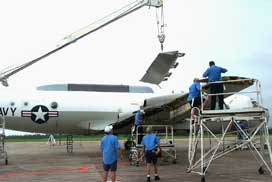 .
. 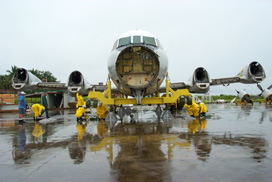
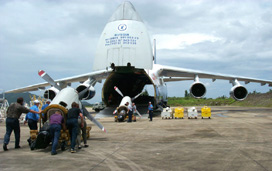 .
. 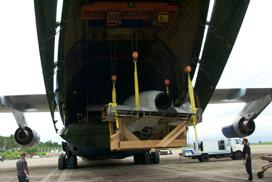 .
. 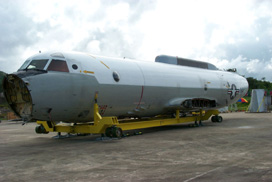
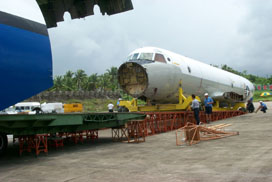 .
. 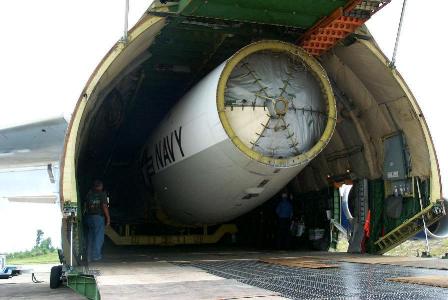
(all photos are Lockheed-Martin courtesy except for the one of the An124 which is an USAF photo. For more see www.pacom.mil)
The Lockheed Martin EP-3E ARIES II
The EP-3E ARIES (Airborne Reconnaissance Integrated Electronic System) was introduced in 1971 after Fleet Air Reconnaissance Squadron ONE (VQ-1) had succesfully been operating two earlier versions, know as the EP-3B "Batrack", since June 1969. The first generation EP-3E aircraft were modified P-3A Orions. Ten P-3As were modified into EP-3E ARIES. These aircraft were operated by VQ-1 (two EP-3B and four EP-3E aircraft) and VQ-2 (six EP-3E aircraft).
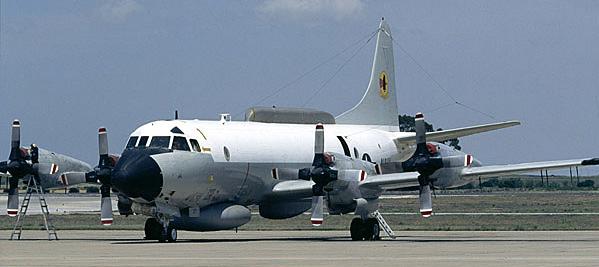
A VQ-2 EP-3E ARIES II at the ramp of its home base NS Rota in Spain (photo: Iwan Bögels)
In 1986 the USN awarded Lockheed with a contract to engineer a follow-on aircraft. Lockheed Aeromod Center in South Carolina was selected to strip the original reconnaissance planes off their operational equipment, modify twelve P-3C Orion airframes to EP-3Es and install the new generation ARIES II equipment onboard of these planes. The first five aircraft were completed by Lockheed Aeromod, while in 1991 the last seven were transferred to the Naval Aviation Depots (NADEP) at NAS Alameda and NAS Jacksonville for conversion. The first EP-3E ARIES II (#156507) made its maiden flight on 11 April 1990. The first five test flights focused on the aerodynamic and flight characteristics of the modified P-3C. Full test flights, which included operational testing of the sophisticated mission equipment, started in May. Deliveries of the ARIES II were delayed by a FY1993 budget discussion about consolidation of the missions of USAF RC-135 and USN EP-3E aircraft and by the relocation of the modification project from LASC Greenville to NADEP Alameda and NADEP Jacksonville.
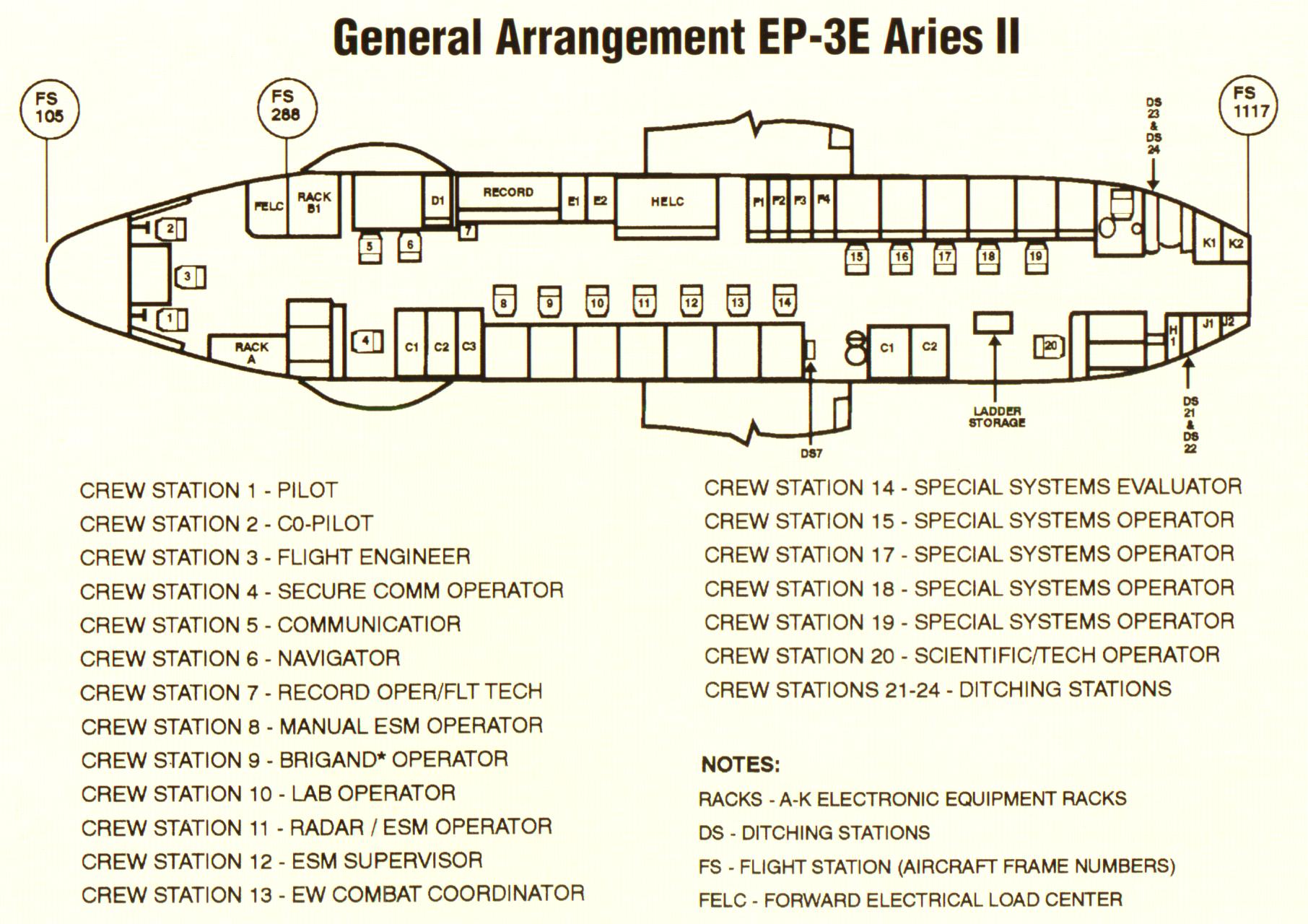
(from several editions of the VQ-2 Welcome Aboard book)
The normal crew of an EP-3E ARIES II consists of 24 members. Amongst them are the Electronic Warfare Aircraft Commander (EWAC), the Senior Electronic Warfare Tactical Evaluator (SEVAL), the Electronic Warfare Aircraft Navigator (EWAN), the Mission Commander (MC) and a couple of Electronic Warfare Operators.
The
Electronic Warfare Aircraft Commander is a pilot with a high degree of maturity, experience and skill. Further he is able to perform professionally under stress. Routinely, his authority greatly outweighs that of his contemporaries in other fields and he bears responsibilities not usually required of other type aircraft commanders during their entire naval career. The EWAC must be constantly aware of the political sensitivities in the area in which he is flying and be prepared to make instantaneous decisions concerning situations which, without the proper reaction, could easily develop into an international incident. He is also capable and responsible for relaying vital intelligence information directly to Fleet Commanders, CNO, NSA or JCS as the situation warrants.The
Senior Electronic Warfare Tactical Evaluator manages the planning, collection and reporting requirements demanded by each mission. The SEVAL must collect signals intelligence (SIGINT) to determine the evolving tactical scenario. This collected information is compiled into an operational intelligence report which reaches the highest echelons in the national reconnaissance chain. The political sensitivities inherent in various areas of operations require the evaluator to be completely knowledgeable in areas of US and foreign strategy, tactics and national objectives.The
Electronic Warfare Aircraft Navigator is an integral member of the flight crew onboard the EP-3E. He must possess a high standard of experience in both naval Aviation and Electronic Warfare and complete all Naval Air Training Operating Procedures Standardization (NATOPS) requirements for the ARIES II. Further, his qualification as a navigator requires a thorough understanding of several navigation systems. The navigator must constantly check the aircraft´s position and maintain precise navigation. This is necessary to ensure precision in the mission data production and to avoid international incidents when flying near hostile countries. Missions in close proximity to non-friendly countries are conducted with the complete reliance on the EWAN`s knowledge of the ruldes for that area.The designation of
Mission Commander is reserved for select individuals (EWAC, EWAN, EVAL) who, by virtue of their extensive knowledge of the principles of electronic warfare, aircraft, operations and crew have been designated by the Commanding Officer of their squadron as the person ultimately responsible for the conduct of the mission. The MC briefs the crew on specific responsibilities and special taskings in light of current political situations.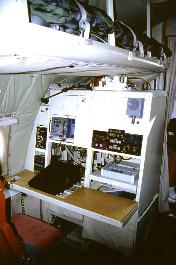 .
. 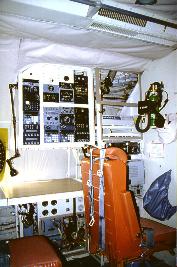 .
. 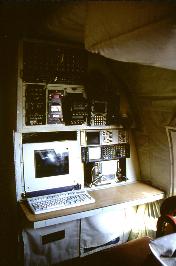
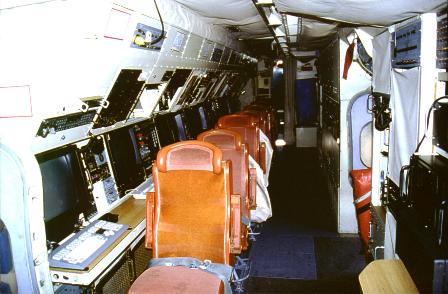 .
. 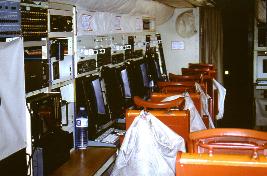
photos of the EP-3E´s interior: first row (left to right) the secure communications station (4), the navigator station (6) and the scientific station (20). Second row (left) station 8 to 14 with 14 in front and (right) station 19 to 20. For the positions in the aircraft see the EP-3E general arrangement diagram on this page (photos: Marco P.J. Borst)
The mission of an EP-3E ARIES II
(from several editions of the VQ-2 Welcome Aboard book)The mission of the EP-3E ARIES II is "to conduct airborne electronic reconnaissance to obtain information on areas and targets of naval and national interest." The reconnaissance aircraft constantly provide Fleet, Joint and National Level Commanders with vital and timely intelligence concerning potentially unfriendly forces. Operating in international airspace either independently or in conjunction with other US Forces, they frequently provide the Fleet Commanders with their only real-time assessment of the tactical posture of unfriendly military forces. While providing intelligence to the fleet in a multi-threat / open ocean environment, the reconnaissance crew, using experience and extensive knowledge, must rapidly determine the evolving tactical scenario by analyzing available information. The ability of the fleet to respond effectively, could ultimately depend upon the skill and efficiency with which the crew interprets and reacts to the changing signal intelligence environment.
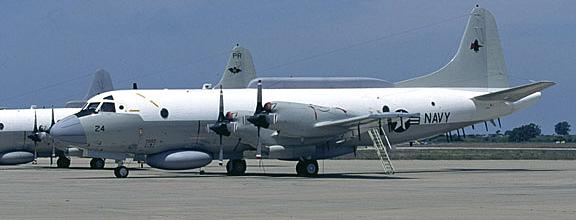
VQ-2´s EP-3E ARIES II Ranger 24 at NS Rota (photo: Iwan Bögels)
The EP-3E ARIES II crew also gathers technical information on weapon systems which could pose a threat to the United States. The ability of the aircraft to relay information directly to US units and ground sites significantly enhances the fleet reconnaissance capability, while the real-time transmission of critical intelligence directly to the national command authority allows decision makers time to react rapidly to key developments in volatile foreign countries.